Camera Face-Off: iPhone 5s vs. Galaxy S5
The iPhone 5s and Galaxy S5 are two of the best smartphones around, but which device takes the best pictures? See the results here.
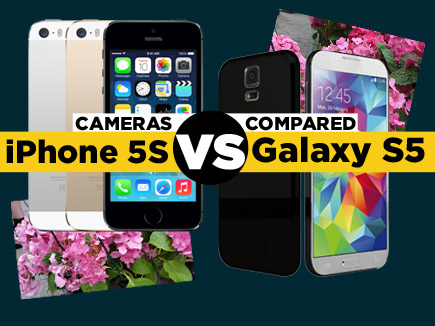
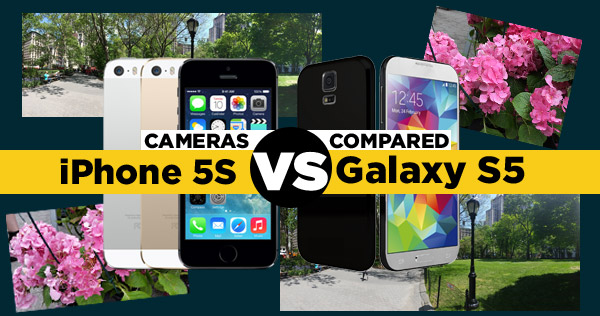
Whether you love to capture tantalizing food photos, shoot stunning panoramas or you’re a habitual selfie-snapper, your smartphone now likely acts as your primary digital camera. So it shouldn’t be a surprise that shoppers are placing more importance on image quality and camera features. The Apple iPhone 5s and Samsung Galaxy S5 pack two of the most advanced smartphone cameras available, but they take different paths.
On paper, the Galaxy S5 beats the iPhone 5s: Its 16-MP rear shooter provides double the megapixels of the iPhone 5s’ 8-MP rear camera. It also boasts more sophisticated autofocus technology. And the Galaxy S5's 2.1-MP front-facing camera trumps the 1.2-MP resolution on the iPhone 5s.
MORE: Best Phone Cameras
On the other hand, the iPhone 5s iSight camera has bigger pixels to capture more light, as well as a True Tone flash for capturing more accurate skin tones. The iPhone 5s has also taken down some other heavy hitters when it comes to image quality, such as the 41-MP Nokia Lumia 1020.
In order to give you a better idea of how the Galaxy S5 and iPhone 5s cameras hold up in the real world, we snapped a bunch of photos and videos in a wide range of settings all over New York City for your viewing pleasure. We also checked our impressions against instrument-based lab tests. Read on to see which device comes out on top.
Camera Features
Samsung wants to make sure you never get bored taking photos with the Galaxy S5, which delivers a healthy serving of shooting options.
The phone's Shot & More function gives you plenty of features for tinkering with a photo after it's taken, including Eraser for removing photobombers and Drama Shot for artistic time-lapse shots. Beauty Face adds an airbrushed feel to selfies, and Virtual Tour mode allows you to provide a digital walkthrough of your home or office. There's also the gimmicky Dual Camera, which stamps a small self-portrait from the front camera on top of anything you shoot with the rear cam.
Perhaps the Galaxy S5's neatest feature is Selective Focus, which allows you to easily blur either the foreground or background of a photo after you have taken it. This effect can provide a professional-looking shallow depth of field you generally only get on high-end cameras with lenses that offer a range of apertures. You can see the effect in these two photos of a bicycle rack. Look at the numbers on each dock in the rack at the bottom of the image. (If a popup ad is obscuring the bottom of the photo, please click the "x" to close it. Or install an ad blocker.)
MORE: 10 Best Ad Blockers and Privacy Extensions
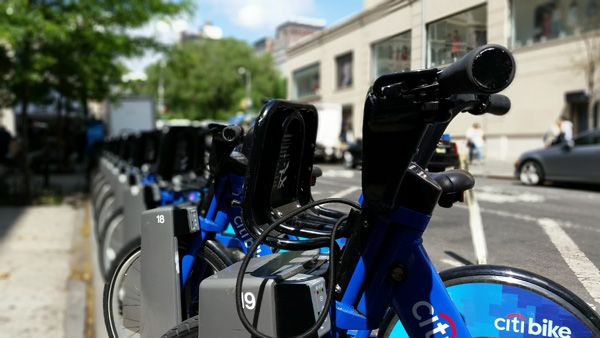
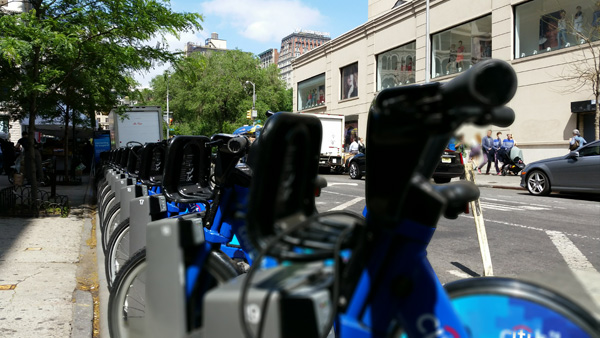
The Galaxy S5 also provides a wealth of advanced settings not found in the iPhone's simplified interface. These include the ability to adjust ISO (light sensitivity) for more control over low-light photography and a selection of light-metering modes to specify what part of the photo the exposure should be optimized for.
By comparison, the iPhone 5s sports a lean array of effects. You can shoot photos in an Instagram-friendly square mode, and Apple provides eight moody filters like the brown-tinted Transfer and the black-and-white Noir. You can tap the iPhone screen to select the point for focus and exposure optimization — the latter achieving much the same effect as the Galaxy S5 light-metering mode.
The good news is that the iPhone has access to a wide array of camera enhancers via apps. The $2 Camera+ for iOS app, for instance, delivers advanced controls like those in the Galaxy S5 app and more, including the ability to set focus and exposure separately and custom-set white balance. It also offers a timer and image stabilization.
Apple has also announced new camera capabilities for the iOS 8 operating system (which will be available as a free upgrade in the fall). The built-in camera app will have the ability to edit aspects of photos including brightness, contrast, highlights and shadows. The iOS 8 system will also allow apps to control aspects of the camera including shutter speed, ISO and focus.
Winner: Galaxy S5. Samsung's latest flagship provides tons of fun ways to shoot images, and many options for photo enthusiasts to tweak settings, without having to go DIY with separate camera apps for the iPhone 5s. It remains to be seen how handy the new camera features in iOS 8 will be.
Bright-Light Image Quality
To test the bright-light image quality of the iPhone 5s and Galaxy S5, we took some sunny outdoor shots in several parts of New York City using each phone's default settings.
First, we photographed a Bronx street filled with colorful store awnings. The red-and-blue laundromat sign was significantly brighter in the S5 photo, and we had an easier time making out text on each storefront in pictures from Samsung's phone.
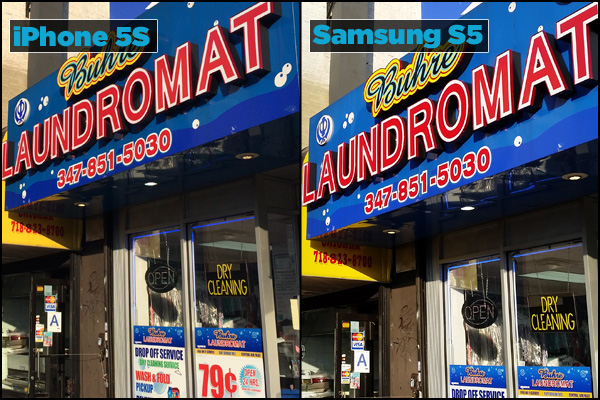
We then headed to Manhattan's Madison Square Park, where we shot some pink flowers. The image produced by the iPhone 5s had richer and more accurate colors.
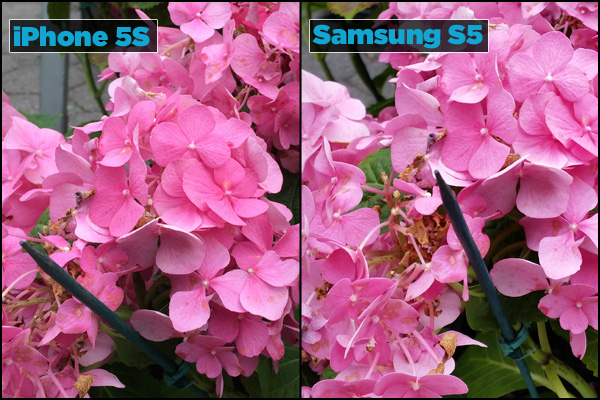
The discrepancy between the results of these first two shots became clear when we evaluated the two cameras in the lab using test patterns and the Imatest analysis software. The results showed that the iPhone camera is far more accurate in the colors it captures. In fact, it's nearly dead-on. The Galaxy S5 is rather inaccurate, particularly in oversaturating colors. In the street scene, this saturation helped emphasize the primary colors that were washed out by bright sun. In the flowers photo, the accuracy of the iPhone captured the subtle shades far better.
MORE: Best Smartphones on the Market Now
According to the lab tests, the Galaxy S5 camera also applies far more image sharpening to photos than the iPhone 5s does: 37 percent for the Samsung phone vs. just 3.5 percent for the iPhone 5s. This may explain why text was sharper in the Bronx street-scene picture taken with the Galaxy S5.(The higher resolution may also be a factor.)
We then took a panoramic shot in Madison Square Park with each phone. No surprise: The S5 version packed slightly more vibrant colors, but both photos were fairly accurate and pleasing. If one appeals more than another, it's simply a matter of taste.
![iPhone 5S Panorama. [Click to enlarge.]](https://cdn.mos.cms.futurecdn.net/2ekbjBqUGPg2LJMmwwVcAd.jpg)
![Galaxy S5 Panorama. [Click to enlarge.]](https://cdn.mos.cms.futurecdn.net/vBsD4LsUk4KLdaXQ9sd3wZ.jpg)
A long-range photo of Manhattan's Flatiron Building looked a bit blown in our Galaxy S5 shot. The iPhone 5s version once again had more accurate colors — as well as better exposure, which allowed it to capture a bluer sky in the background by not overexposing it.
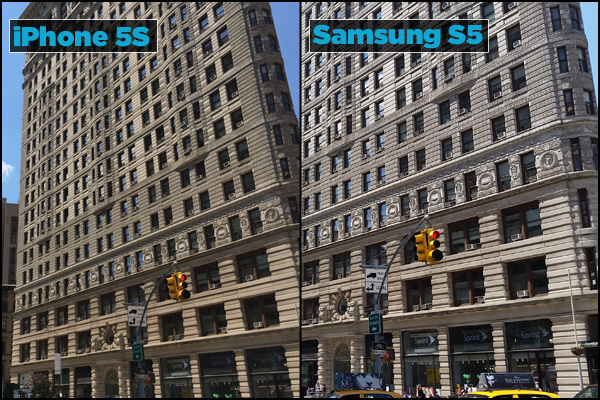
Last but not least, we took to our office rooftop to photograph a co-worker, whose ruddy skin tone looked a smidgen more accurate in the Samsung photo. As with previous photos, however, the colors of the buildings and sky in the background looked richer in the 5s photo.
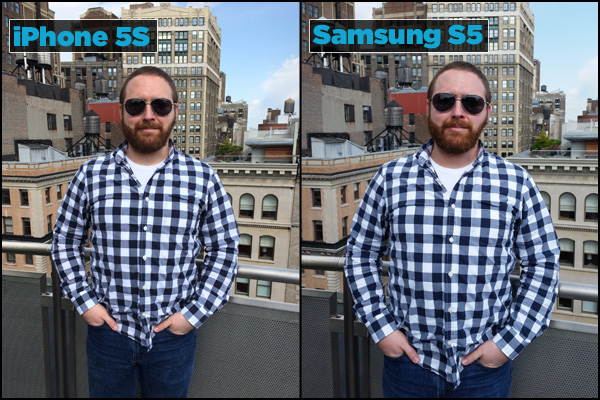
Winner: Draw. Both phones have their strengths and weaknesses under bright light. Though the Galaxy S5 is technically less accurate, its more saturated colors help combat the washed-out look that bright sunlight causes. Some may also find its hues more pleasing. In less harsh light and in overall exposure quality, the iPhone excels.
Low-Light Image Quality
You're not always going to be snapping photos outdoors on a sunny day, which is why we tested the iPhone 5s and Galaxy S5 in several low-light situations.
First we took things indoors, where we photographed an assortment of plastic toys under a mix of fluorescent and incandescent office lights. The iPhone 5s photo's color balance had a yellowish cast that is obvious in what should be the white background and in the astronaut's white spacesuit. The Galaxy S5 image had better white balance, though that may have been a happy accident. We generally found its images to be "cooler" or bluer than the iPhone 5s photos. In this case, the blue bias may have been just what the photo needed to combat the orangey lighting.
The Galaxy S5 photo suffered from more graininess but this was only visible when the photos were blown up to nearly full size — an unlikely scenario for a cameraphone snap.
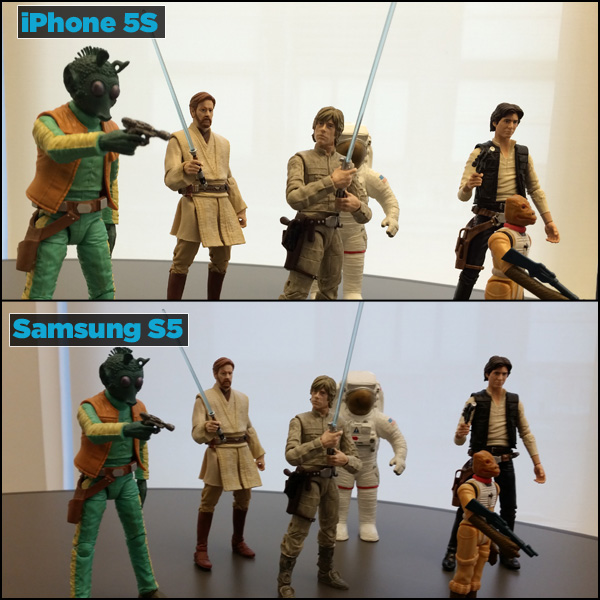
When capturing two co-workers in a dimly lit conference room, the iPhone 5s was the superior shooter with the flash off. With minimal lighting, the iPhone 5s' rear camera produced a bright image that allowed us to see the finer details of our subjects' clothing, as well as the gray foam ridges on the wall.
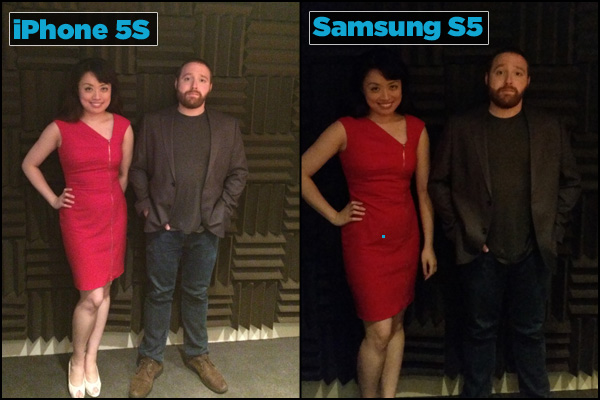
By comparison, the Galaxy S5's no-flash shot was dim and less detailed; our colleague's brown hair became engulfed by the gray background.
After we turned on flash for both phones, the iPhone 5s continued to excel, thanks to its True Tone LED flash, which mixes a "warm" (amber) LED light with a "white" (actually bluish) LED light in accordance with the ambient light to achieve a better color balance. Our iPhone 5s flash shot provided warm, accurate skin tones and plenty of clothing detail, while its Galaxy S5 equivalent looked pale by comparison.
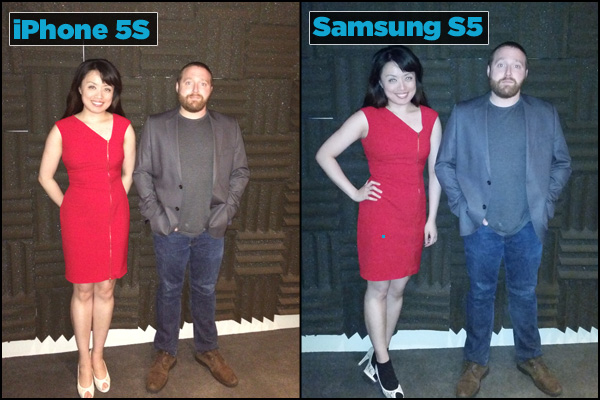
Outdoor photos at night told the same story. When we tried to photograph a statue in front of a church, the Galaxy S5 photo showed only a silhouette, whereas the better light sensitivity of the iPhone 5s camera — possibly due to the larger pixels in its sensor — made the statue's features clearly visible. (Even using HDR mode didn't have a noticeable effect on the Galaxy S5 results.)
MORE: How Many Megapixels Do You Really Need?
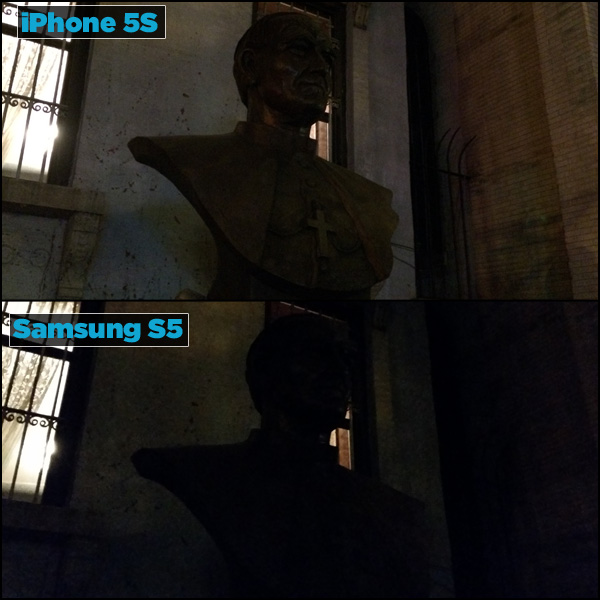
The differences were subtler under better lighting in front of a restaurant. As in other photos, the Galaxy S5 oversaturated the image, in this case adding too much yellow. The iPhone 5s photo colors are more accurate, but the photo is darker and less vibrant looking. (Accuracy doesn't always produce the most appealing pictures.)
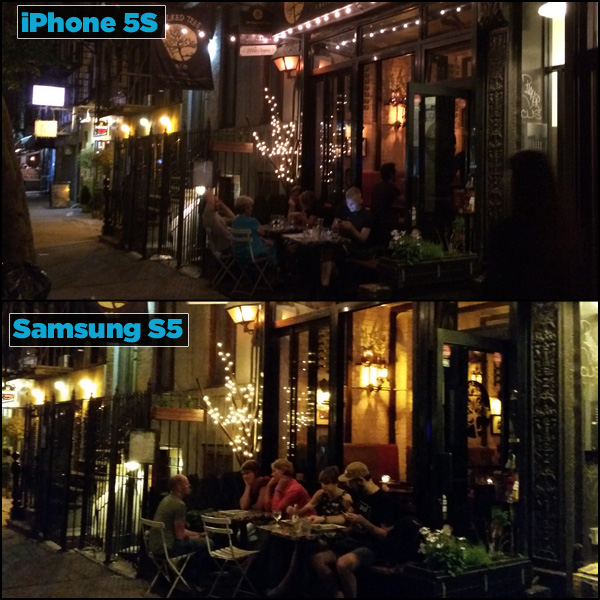
As in other cases, our lab tests back up our real-world observations. Without altering either phone's default settings, the photos of our test chart consistently showed better white balance for the iPhone 5s. And color balance is often most difficult to achieve under low light.
Winner: iPhone 5s. You can count on the iPhone 5s to take detailed, nuanced shots, generally with better color accuracy in low light — with or without flash.
HDR Performance
Both the iPhone 5s and Galaxy S5 support high-dynamic-range (HDR) imaging, which is meant to brighten dim parts of photos and tone down the brightness of overexposed elements. HDR does this by taking multiple images at different exposures and combining them into one image. That slows the picture-taking process and is more likely to produce blurry photos, especially in shots with action. So HDR should only be used when you really need it.
MORE: Best Bridge Cameras
To test how each device holds up in extreme brightness, we snapped images in front of a gothic-style church on Broadway. Some of the light stonework is in bright sunlight, while other parts of the sculptures and the entranceway are in shadow.
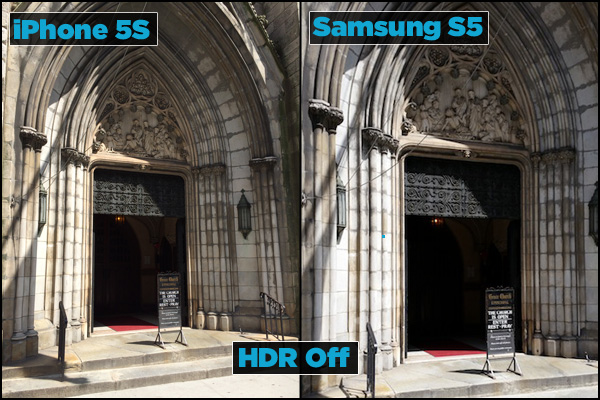
Even without HDR, the iPhone 5s was able to show a lot of the shadow detail. Adding HDR revealed a bit more of the very dark interior. The Samsung Galaxy S5 photo missed much of the shadow detail in regular mode, but matched the quality of the iPhone in HDR.
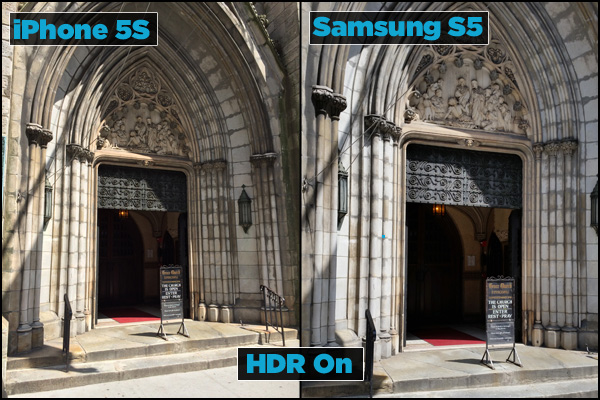
The two phones produced notably different results when we shot inside a building with an elegant lobby featuring marble walls, an intricate coffered ceiling and bright wall-sconce lamps. The iPhone 5s HDR photo looks scarcely different from a photo shot without HDR mode. It does recover a bit of detail in the frosted-glass light shades and puts a bit of glint on the dark ceiling, but the overall effect remains way blown-out lights and a barely discernable ceiling.
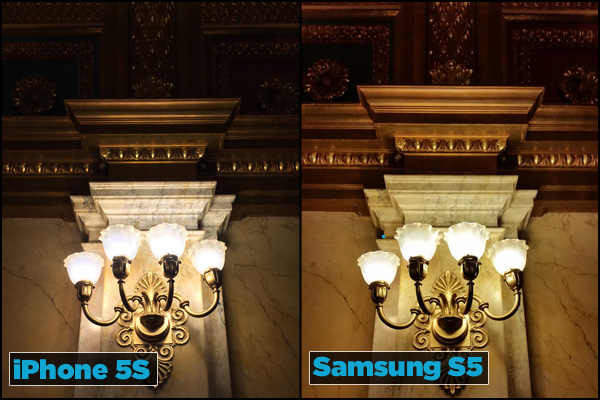
The Galaxy S5 opens the scene up, taming much of the overexposure from the lights and brilliantly illuminating the ornate ceiling. The color is less accurate — in this case with a bit of a green tint. That's in line with our other real-world tests and lab tests that show the iPhone has better color fidelity and white balance, but the brightness and detail in the Galaxy's photo far outweigh the color downside.
As a bonus, the Galaxy S5 displays a real-time preview of the HDR result, so you can see exactly what you will get. Samsung's phone can also apply HDR to video recording, which the iPhone cannot (in our test, we didn't see much difference with the HDR video mode, however).
Winner: Galaxy S5. The iPhone 5s' tiny performance gain scarcely merits being called HDR in comparison to the dramatic exposure improvement the Galaxy S5 camera produces.
Front-Facing Camera (Selfies)
Even if you despise the word "selfie," you're probably going to end up snapping a few self-portraits if you own one of these two phones. And while the Galaxy S5's 2.1-MP front camera packs more pixels than the iPhone 5s' 1.2-MP front cam, Apple's handset is the far superior smartphone for the self-indulgent.
In a selfie we snapped with the 5s, skin tones looked accurate and individual birthmarks were easy to distinguish. Our S5 self-portrait looked pale by comparison, and we had a hard time making out birthmarks and facial stubble.
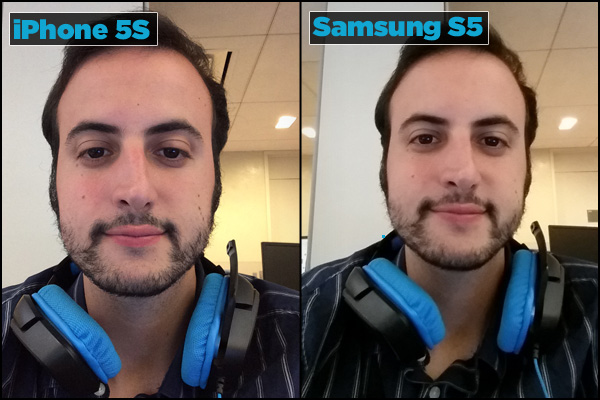
The Galaxy S5's front camera does offer an airbrushed Beauty Face filter, but this novelty feature ends up removing even more detail from selfies.
Winner: iPhone 5s. Despite having a lower-resolution front camera, the iPhone 5s is the superior selfie-taker.
Video Quality
The iPhone 5s and Galaxy S5 both shoot 1080p video, with the iPhone maxing out at 30 frames per second and the Galaxy S5 at a faster 120 fps. They both also have slow-motion capabilities — the iPhone offering one-half speed playback and the Galaxy S up to one-eighth speed (each at 720p). The S5 benefits from real-time HDR for brighter clips, as well as image stabilization. Finally, the Galaxy S5 is able to capture 4K video at 30fps — a rare capability for any consumer camera, but not a very useful one until 4K TVs are more common and affordable.
We began by shooting an impromptu, late-day game of soccer on the pavement of Union Square. Such fast action, and panning to follow it, is hard for any camera that isn't designed primarily for video, even a DSLR. Given that, the two phones performed relatively well, but the iPhone 5s had better video processing. In particular, Apple’s device minimized a problem called rolling shutter or "jellocam," in which fast-moving objects become distorted because the image sensor can't read data fast enough to keep up. (Note: If videos appear choppy, it's due to a hiccup in your Internet connection.)
The Samsung Galaxy S5 video suffered more from jellocam. In several frames, players turned into abstract blobs or completely lost a leg. Granted, you won't be watching action videos one frame at a time, but these errors add up to a subtle effect that makes the Galaxy S5 video less clear than the iPhone's.
The S5 video was also much shakier in its default mode, which we used to shoot the game. However, the camera offers image stabilization for video, which we turned on to film double-Dutch jump ropers the following day. This made all the difference, eliminating the jitters and minimizing jellocam.
MORE: How to Shoot Great Video
Color quality was close in both videos, with the iPhone footage appearing a tad warm and the Galaxy S video a tad cool. But neither was clearly better at capturing the scene.
As with still photos, the Galaxy S5 offers many more bells and whistles. The iPhone's one video effect is the ability to shoot at high speed in order to play back the video at one-half speed slow motion. The Galaxy S5 offers one-half, one-quarter and one-eight slow-mo, as well as the ability to speed up video by the same three factors. Yet another feature, Audio Zoom, amplifies sound from a person or object you zoom in on. This worked reasonably well when we tested it with street musicians, zooming in on one instrument, but it distorted the sounds of the other instruments on the periphery.
Winner: Draw. Going purely on default settings, the iPhone 5s would win for its better stability and lesser jellocam. But simply pressing the Video Stabilization button in the Galaxy S5 settings menu makes it a nearly equal performer (and one that offers more fun effects).
Speed
Image quality is important, but it's useless if your camera is so slow that you miss the photo completely. We evaluated both start-up time and shutter speed to see which camera can better keep up with real life.
Apple's phone was far quicker to open its camera app. Activating the camera from the lock screen took an average of 0.8 seconds on the iPhone 5s, while the Galaxy S5's camera app took more than 2 seconds to get started.
The iPhone is also a much faster shooter. To compare raw speeds, we hit the shutter button on each device at the same time. The iPhone 5s proved the faster phone each time, as it finished taking its pictures just under a second quicker than the Galaxy S5.
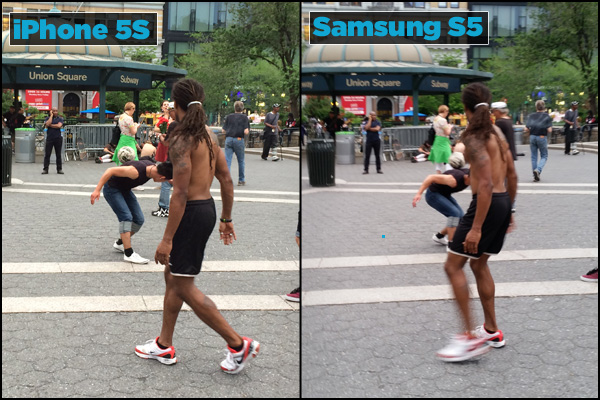
This was surprising, since the Galaxy S5 boasts the DSLR-style phase-detection AF, while the iPhone 5s merely sports the contrast-detection technology found in most point-and-shoot cameras. But the results were undeniable. Not only was the iPhone faster to snap pictures, it was also far more likely to capture crisp action shots, as we saw while reviewing dozens of photos from the soccer game — both those taken in single-shot mode and in burst mode. (For more about AF tech, see Why Autofocus is the New Megapixel.)
Winner: iPhone 5s. Apple's smartphone is a bit faster when it comes to opening the camera and is the clear winner in capturing action shots.
Overall Winner
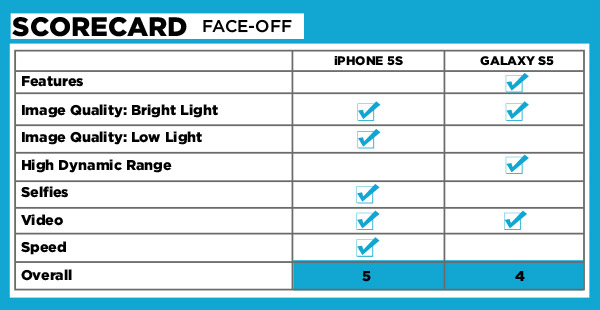
The Samsung Galaxy S5 packs a sharp 16-MP camera and tons of neat built-in features. But the Apple iPhone 5s' 8-MP iSight shooter was more consistent in producing detailed and natural-looking shots, with good exposure and more accurate color — making it more of a photographer's phone camera. Each device showed its strengths when shooting in bright light, but the iPhone 5s' low-light performance makes it a standout. Apple's phone also snapped photos almost a second quicker than the S5 and nailed focus more often, helping ensure you don't miss that fleeting moment.
If you want a smartphone that's jam-packed with fun ways to customize your photos, there's plenty to love about the Galaxy S5. However, when it comes to overall quality, the iPhone 5s is the winner.
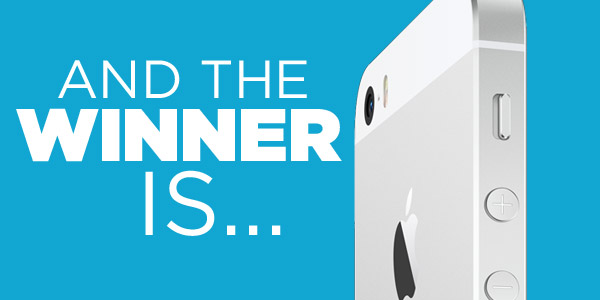
Follow Mike Andronico @MikeAndronico and on Google+. Senior editor Sean Captain contributed to this review. Follow him @seancaptain and on Google+. Follow us @tomsguide, on Facebook and onGoogle+.
Sign up to get the BEST of Tom's Guide direct to your inbox.
Get instant access to breaking news, the hottest reviews, great deals and helpful tips.
Mike Andronico is Senior Writer at CNNUnderscored. He was formerly Managing Editor at Tom's Guide, where he wrote extensively on gaming, as well as running the show on the news front. When not at work, you can usually catch him playing Street Fighter, devouring Twitch streams and trying to convince people that Hawkeye is the best Avenger.
-
MayTang5 Hi, I have read your articles, it's really great, so I would like to send a phone for you to review. Contact with me via the email <gearbest.may@gmail.com> please, if you are interested.Reply

